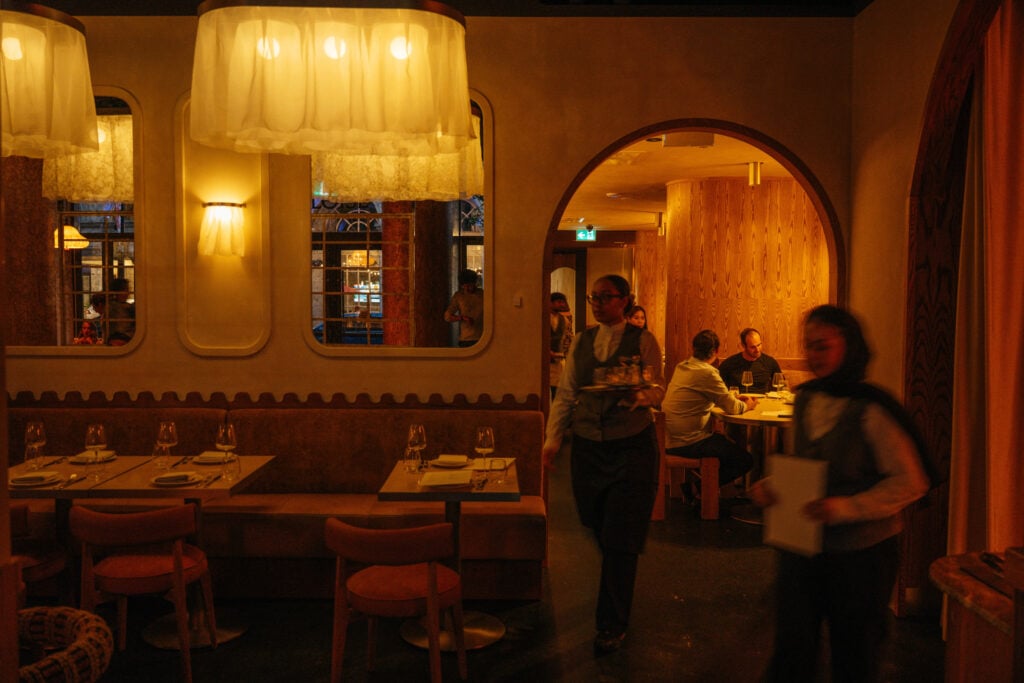On the Esplanade, two contrasting venues seamlessly connect from business lunch to happy hour
For years, Graham and Dan Hnatiw watched as residents of their beloved St. Lawrence Market neighborhood piled into an Uber to head west in search of nightlife. And who could blame them? It's hard to compete with places like Ossington, College and Dundas West, where a trendy new restaurant, wine bar or cocktail joint seems to open almost every week. That's exactly the audience the restaurateurs were hoping to attract with their latest venture, Eloise and Bar Cart, which opened this summer at 42 The Esplanade – just steps from their old stomping grounds, the Old Spaghetti Factory, which has been in the family since the early '70s.
Today's Eloise and Bar Cart used to be, of all things, a Shoeless Joe's. But behind the schmaltzy decor of a chain restaurant, the Hnatiw brothers saw potential for not one, but two upscale eateries in the neighborhood. They decided to divide the space, creating an elegant dining room during the day and a chic cocktail lounge at night. Credit for designing both venues goes to Keri MacLellan, founder of local studio Westgrove. And they couldn't be more different.
Soft, elegant and warm, entering Eloise is like a breath of fresh air. Inspired by old-world luxury travel – particularly the Orient Express – the interior features wood paneling and plush velvet upholstery. In the wrong hands, these precious materials could appear heavy. But here they're balanced by light and airy pendants, each wrapped in springy white draping that adds a touch of whimsy.
While the design appears deceptively understated, there are plenty of thoughtful details at every turn. The same goes for the menu, which takes simple ingredients like cabbage and Dover sole and elevates them beyond recognition (with an umami mushroom XO sauce and chicken velouté, respectively).
Inside, it starts with the art: a series of expressive, almost geometric portraits by Victoria Sequeira, around which McLellan says she planned the space. “My brain turned to Art Deco and mid-century, so I used a lot of color palettes from that period,” Sequeira explains of the pieces, which feature a palette of earthy tones such as ocher, sage green and terracotta – with subtle hints of gold leaf that reflect the luxurious appeal of Eloise’s design. In one particularly striking piece, a woman looks out the window, bringing the train carriage reference full circle. Even the frames add to the atmosphere, with a series of spherical appliqués that “extend the artwork beyond the canvas.” The organic shapes of the portraits are repeated throughout the interior—in the arched doorways, the notched moldings above the bench seating, and even the Art Deco-inspired lighting fixtures.
As you walk past a corridor of booths to the back of the restaurant, where an eating bar offers a close-up look at what's happening in the kitchen, you catch a glimpse of red through an interior window—a hint of what you'll find next door at Bar Cart, a speakeasy of sorts that serves cocktails and snacks. “There’s a surprise around every corner,” says McLellan. “However, from the outside you shouldn’t know that it even exists.”
Behind a discreet black door, the entrance vestibule sets the tone, wrapped in a shimmering wallpaper that mimics the wood grain but is somehow reminiscent of animal motifs. In front of the burl wood paneling, a row of miniature stools provides a place to wait for your table.
While Eloise is more timeless and traditional, Bar Cart is a playful counterpart – think foie gras served with a side of waffles and skewers of curly mortadella – and its design reflects this. “We didn’t want to just open another bar, we wanted to create a conversation piece,” says Graham Hnatiw. From the wallpaper to the chairs to the benches, the entire interior is bathed in a rich oxblood red. However, there are nods to Eloise, such as the gray curtain that hangs over the bar, tying the two concepts together into a cohesive vision.
“Eloise and Bar Cart are the result of finally having the freedom to design, iterate and dream without constraints,” says Dan Hnatiw. “These are places that celebrate timeless hospitality and the art of togetherness.”
